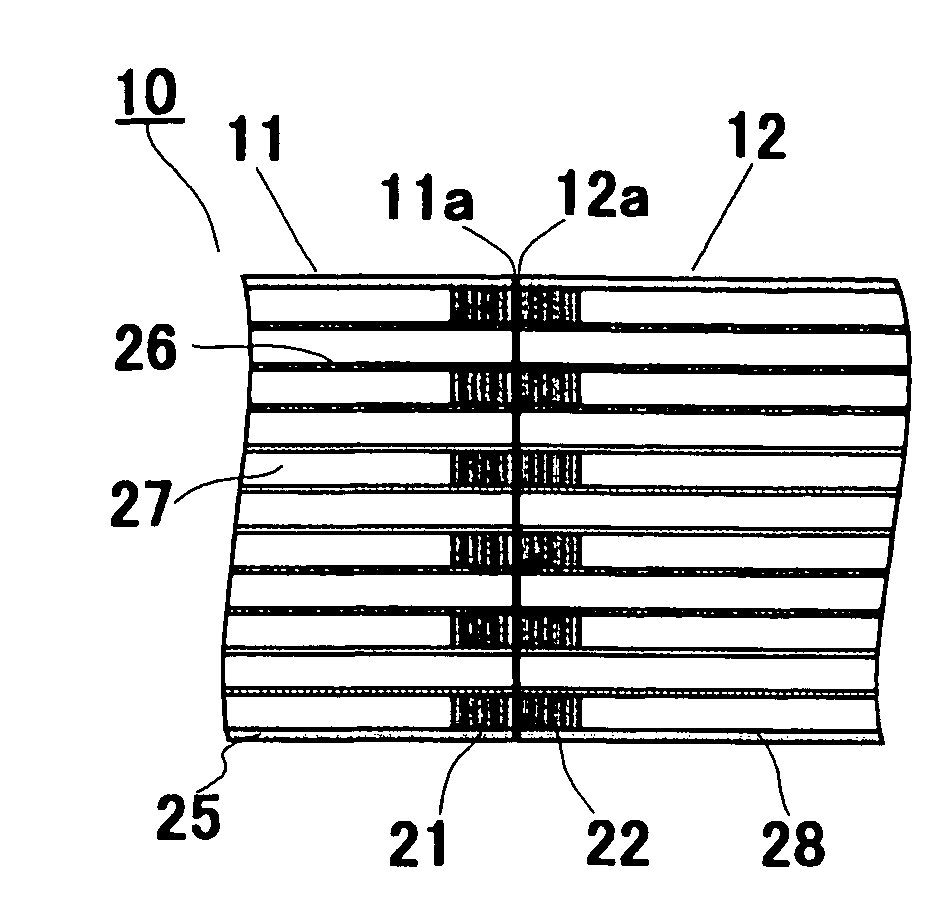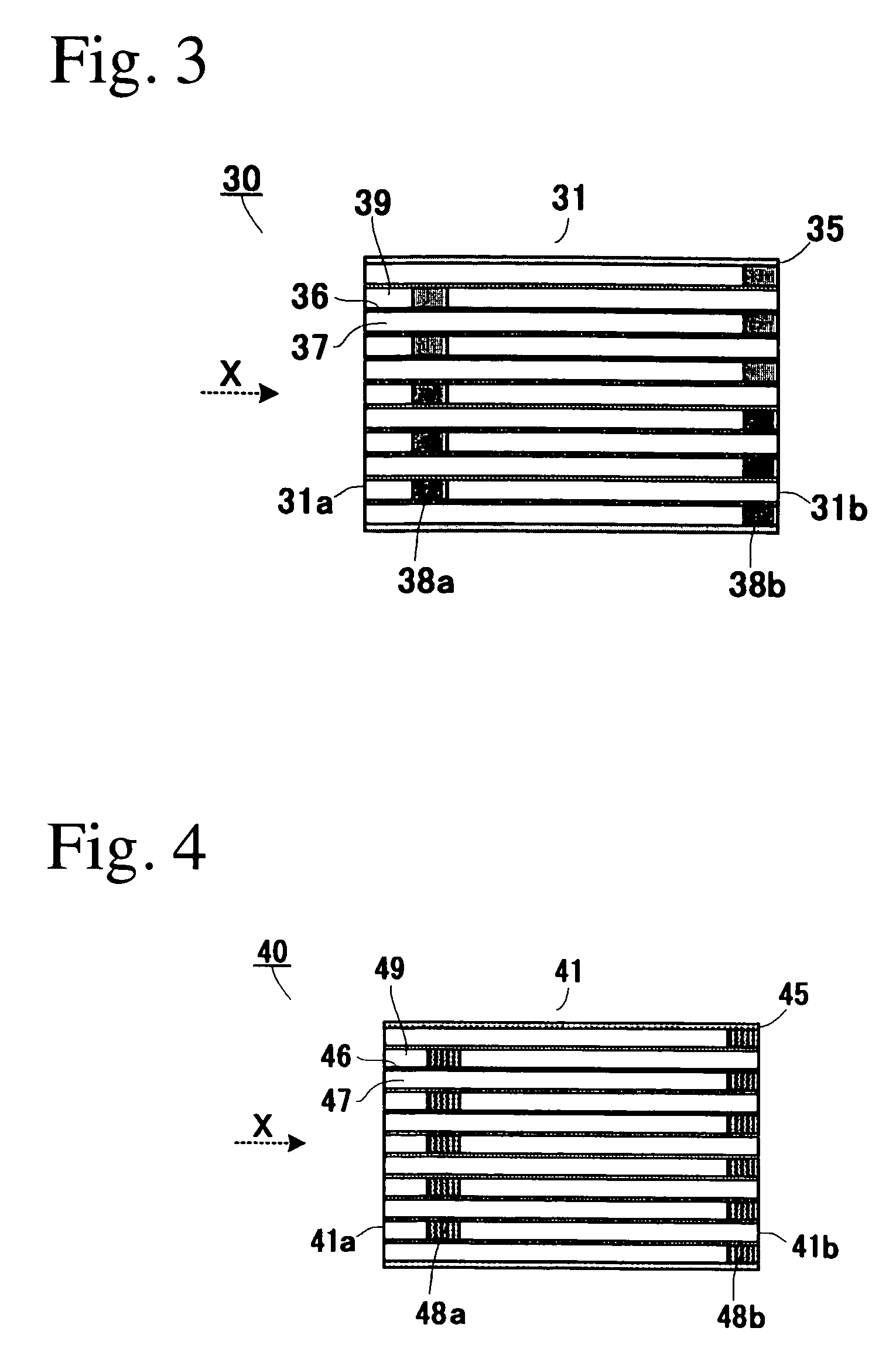Ceramic honeycomb filter and its production method
a honeycomb filter and ceramic technology, applied in the field of ceramic honeycomb filters, can solve the problems of increased pressure loss and engine power, difficult regeneration of honeycomb filters, and reduced capturing function, so as to achieve efficient regeneration
- Summary
- Abstract
- Description
- Claims
- Application Information
AI Technical Summary
Benefits of technology
Problems solved by technology
Method used
Image
Examples
example 1
[0070]The ceramic honeycomb filter 10 of Example 1 shown in FIG. 2 is made of a cordierite ceramic, having an outer diameter of 267 mm, a length of 304.5 mm, a cell wall thickness of 0.3 mm, a cell wall pitch of 1.5 mm, a cell wall porosity of 65%, and an average pore diameter of 22 μm. Inlet-side plugs were positioned 92 mm from the inlet end. The ceramic honeycomb filter 10 was constituted by integrally bonding a honeycomb structure 11 having plugs 21 at one end to a ceramic honeycomb structure 12 having plugs 22, 23 at both ends, with these plugs aligned in the direction of the flow paths 27.
[0071]A cordierite-forming material powder comprising powders of kaolin, talc, fused silica, aluminum hydroxide, alumina, etc. was fully dry-mixed with methylcellulose as a molding aid, and graphite and an organic foaming agent as pore-forming agents, and then mixed with water, and further fully blended to form a ceramic material with moldable consistency. This ceramic material was extrusion-...
example 2
[0076]The ceramic honeycomb filter 10 of Example 2 shown in FIG. 11(b) was made of cordierite ceramic, having an outer diameter of 267 mm, a length of 304.8 mm, a cell wall thickness of 0.3 mm, and a cell wall pitch of 1.5 mm, the cell walls 26 having a porosity of 63% and an average pore size of 21 μm. The inlet-side plugs were positioned 92 mm from the inlet end. The ceramic honeycomb filter 10 was constituted by integrally bonding a honeycomb structure 11 having plugs 21 at one end to a ceramic honeycomb structure 12 having plugs 22, 23 at both ends, with these plugs aligned in the direction of the flow paths 27.
[0077]The ceramic honeycomb filter 10 was produced as shown in FIGS. 9(a)-(g). FIG. 9(a) shows a green body 1 extruded in the form of a honeycomb and dried, FIG. 9(b) shows a honeycomb structure sintered after a peripheral portion of the extruded green body 1 was removed by machining, FIG. 9(c) shows honeycomb structures 11, 12 obtained by cutting the sintered honeycomb s...
example 3
[0094]The ceramic honeycomb filter 10 of Example 3 shown in FIGS. 14(a) and 14(b) was made of cordierite ceramic, having an outer diameter of 267 mm, a length of 304.3 mm, a cell wall thickness of 0.3 mm, and a cell wall pitch of 1.5 mm, the cell walls 26 having a porosity of 65%, an average pore size of 22 μm, and a surface roughness of 45 μm. The inlet-side plugs were positioned 92 mm from the inlet end. The ceramic honeycomb filter 10 was constituted by integrally bonding a first honeycomb structure 11 having plugs 21 at one end to a ceramic honeycomb structure 12 having plugs 22, 23 at both ends, with these plugs aligned in the direction of the flow paths 27.
[0095]The ceramic honeycomb filter 10 was produced as shown in FIGS. 16(a)-(f). FIG. 16(a) shows a honeycomb structure 1 after sintering, FIG. 16(b) shows a honeycomb structure 1 with inclined cell walls, which was obtained by removing a peripheral portion from the honeycomb structure 1 of FIG. 16(a), FIG. 16(c) shows honeyc...
PUM
| Property | Measurement | Unit |
|---|---|---|
| depth | aaaaa | aaaaa |
| width | aaaaa | aaaaa |
| width | aaaaa | aaaaa |
Abstract
Description
Claims
Application Information
 Login to View More
Login to View More - R&D
- Intellectual Property
- Life Sciences
- Materials
- Tech Scout
- Unparalleled Data Quality
- Higher Quality Content
- 60% Fewer Hallucinations
Browse by: Latest US Patents, China's latest patents, Technical Efficacy Thesaurus, Application Domain, Technology Topic, Popular Technical Reports.
© 2025 PatSnap. All rights reserved.Legal|Privacy policy|Modern Slavery Act Transparency Statement|Sitemap|About US| Contact US: help@patsnap.com



